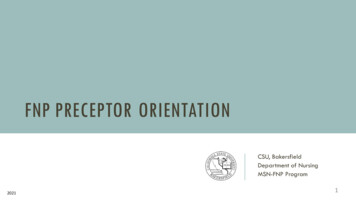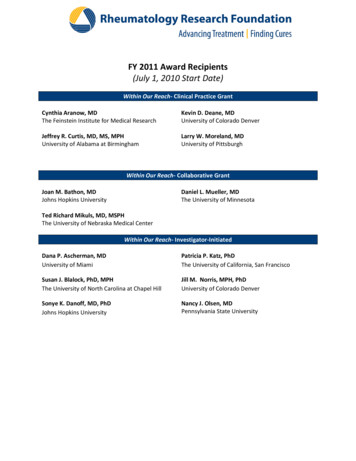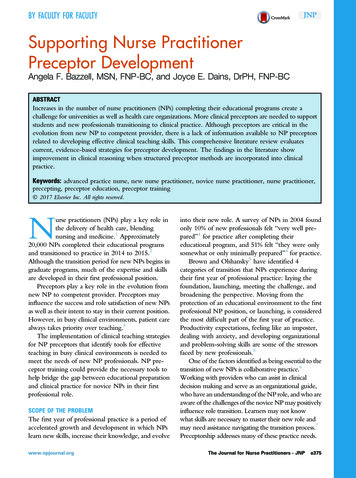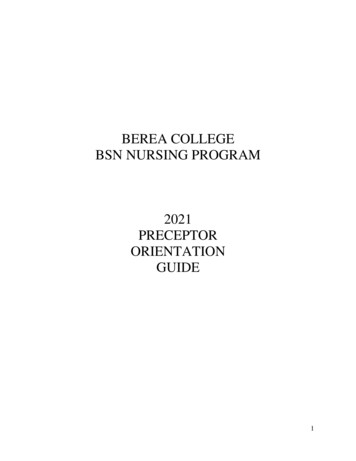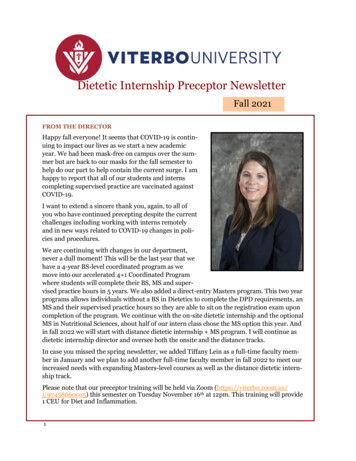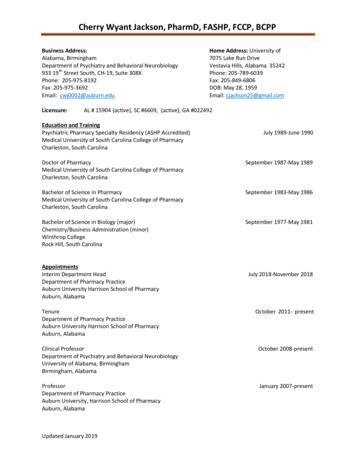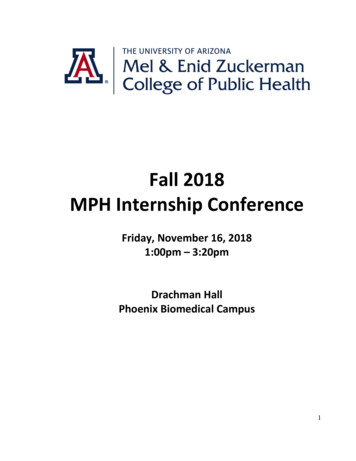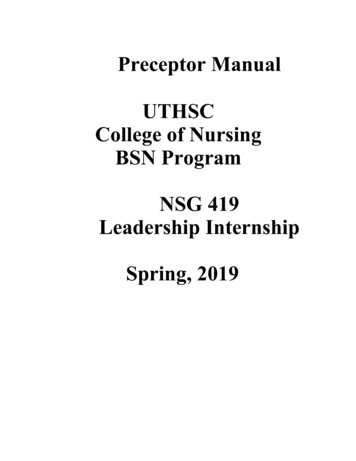
Transcription
Preceptor ManualUTHSCCollege of NursingBSN ProgramNSG 419Leadership InternshipSpring, 2019
Dear Preceptor,The faculty and students of UTHSC College of Nursing would like to thank you forserving as a leadership preceptor. The role that you play in mentoring leadership studentsis an important one for the future of nursing. We look forward to working with you in ourleadership journey.This manual is designed to assist you in your role. You will find included:§ An introduction to the NSG 419 Leadership Internship course.§ Descriptions of the role of preceptor, student, and faculty.§ Syllabus which describes the course outcomes and learning activities.§ Skills list from all courses§ Internship Schedule§ Clinical Hours Log§ Leadership Journal§ Clinical evaluation of the student§ Preceptor FAQsThank you,Sherry Webb DNSc, RN, CNL, NEA-BCAssociate Professor and ChairCourse CoordinatorUTHSCCollege of Nursingswebb14@uthsc.edu
ABOUT THE UNIVERSITY OF TENNESSEE HEALTH SCIENCE CENTER COLLEGE OFNURSINGVision Statement: Nurses Leading Innovative Transformation of HealthcareMission Statement: To prepare exceptional nurse leaders to meet the health needs of thepeople of Tennessee, the nation and beyond through: Cultivating creativity and passion to improve health careLeading scientific innovations and clinical practiceUsing innovative academic approachesServing societyOur values represent who we are regardless of changes in our environment. We value: A culture that creates, supports, and promotes innovation while honoring our traditions;A sense of community and teamwork within the college, with our colleagues, and withour strategic partners;A community that enhances scholarship and promotes diversity;Professional and personal accountability;Respectful, open, and transparent communication and collaboration;Professional and intellectual integrity;Shared respect for faculty and staff contributions.University of Tennessee Health Science Center
NSG 419Leadership InternshipIntroductionCourse DescriptionThe clinical leadership internship provides baccalaureate nursing students the opportunity,within a select area of interest, to facilitate role transition and lifelong learning. Emphasis willbe on integration and application of knowledge and skills in order to demonstrate the ability todesign, provide, manage, and coordinate evidenced – based, culturally competent, and costeffective nursing care for a group of patients. This is accomplished in partnership with thestudent, preceptor, and nursing faculty.Course OutcomesUpon completion of this course, the leadership student will be able to:1. Integrate knowledge from nursing, the sciences, and humanities in delivering nursingcare for a cohort of patients.2. Coordinate care to a group of patients across the continuum based on desired outcomesconsistent with evidence-based guidelines and quality care standards.3. Demonstrate accountability for personal and professional behavior.4. Assume leadership roles within the scope of nursing practice5. Collaborate with interprofessional team in implementing, evaluating, and revising theplan of care for clients and their families6. Demonstrate best practices in the delegation of care.7. Use technology and information systems effectively for the management of resources andpatient outcomes.8. Formulate individual goals for lifelong learning.9. Assume accountability for professional development.BSN Program
The Leadership Internship course begins the week of March 25 – May 18, 2018.Internship Preceptor Qualifications:The preceptor is a leadership role model who guides, consults, and mentors the leadership student in achievingthe clinical course outcomes. Preceptors will be selected by the clinical director and should have the followingqualifications: Clinically competent Viewed by staff as a leader Completed the hospital preceptor course Enjoys working with nursing studentsStudents, preceptors, and faculty will partner to ensure attainment of the leadership internship clinical courseoutcomes. The specific roles that each have is described below:Preceptor Role: Serves as a professional role model consistent with the scope of practice of the registered nurse. Assigns students to patients based on course content, patient/family needs and students’ learning needs. Provides direct observation and supervision of the student consistent with student learning needs,course, program outcomes, and hospital policies. Seeks out learning opportunities consistent with student learner and course outcomes. Communicates effectively with ITP team, patients/families, students and clinical faculty. Supports the students’ growth in the use of evidence-based practice. Provides ongoing and timely feedback to the student regarding learning needs and performance. Provides ongoing and timely feedback to the clinical faculty regarding students’ learning needs andperformance. Notifies the clinical faculty immediately with concerns about student or patient safety. Assists students in gaining an understanding of the microsystem’s mission, goals, care delivery model,ITP team, patient population, and procedures. Contributes to the mid-term & final clinical evaluation.Student Role: Demonstrates knowledge of clinical course outcomes. Applies leadership theory to clinical practice. Demonstrates professional values & leadership behaviors. Works schedule of preceptor on scheduled clinical days. Maintains contact numbers for preceptor & faculty in PDA/smart phone. Provides safe nursing care for a cohort of patients. Demonstrates ability to organize, prioritize, provide & manage nursing care for a cohort of patients. Identifies own learning needs & seeks out learning opportunities. Develops collaborative relationships with preceptor, unit manager/PCC/charge nurse, interprofessionalteam, and clinical faculty. Collaborates with preceptor and faculty to achieve professional and clinical competencies. Demonstrates professionalism through on-time attendance, appearance, communication, quality work,meeting pre-established deadlines, and timely notification of faculty, preceptor & nursing unit. Participates in mid-term & final evaluation conference.UTHSC Faculty Role: Serves as professional role model for students, preceptors & staff.
Communicates to the preceptors and clinical directors the expectations for the course.Communicates on supervisory rounds with student and preceptor to ensure attainment of courseoutcomes.Provides feedback to student related to demonstration of professional values and leadership behaviors.Guides students’ analysis of nursing leadership structures and processes through weekly feedback onleadership internship journal.Ensures availability to student and preceptor by pager and/or e-mail if questions/problems arise.Collaborates with preceptors to ensure that the clinical experiences of the student provide sufficientpractice to achieve clinical competencies.Collaborates with preceptors to complete mid-term & final evaluation.Assumes responsibility for the final grade for the course.UNIVERSITY OF TENNESSEE HEALTH SCIENCE CENTERCOLLEGE OF NURSING
COURSE NUMBER:NSG 419COURSE TITLE:InternshipCREDIT HOURS:4 (0-4)COURSE FACULTY:Sherry Webb, DNSc, RN, CNL, NEA-BCPREREQUISITES/COREQUISITES:Term I, II and Summer or permission by the Associate Dean ofAcademic AffairsPLACEMENT IN CURRICULUM:Term IIIFaculty Contact Information/Availability:FacultyOfficeOffice HoursDr. SherryWebbDr. Jami SmithBrownAlise FarrellMSN920 Madison Ave.By AppointmentSuite 952920 Madison Ave.By AppointmentSuite 1017920 Madison Ave.By AppointmentSuite 1009PhoneAnita Seymour 920 Madison Ave.MSNSuite 1006By AppointmentOffice 448-2720Cell # 482-5845Terri StewartMSNBy AppointmentOffice 448-2053Cell # 237-9672920 Madison AveSuite 932Email AddressesOffice 448-4148swebb14@uthsc.eduCell # 482-4774Office 448-1939jsmit361@uthsc.eduCell # 601-454-9703Office 448-4145agfarrell@uthsc.eduCell # 573-3348Dr. Trina920 Madison Ave.Office 448-1886By AppointmentBarrett CCRN Suite 1015Cell # 326-8892Pat Purdy-Jones 920 Madison Ave. By Appointment Office 448-2195MSNSuite 1015Cell # t6@uthsc.edupjonespu@uthsc.eduUTHSC COLLEGE OF NURSING TOLL FREE NUMBER: 800-733-2498. The toll-free number workswithin the continental United States and is answered from 8 am - 5 pm central time Monday through Friday.FACULTY WEB PAGE: Available in the Staff Information section on Blackboard within the course.COURSE DESCRIPTION:The clinical internship provides the opportunity, within a selected area of interest, to facilitate role transitionand lifelong learning. Emphasis will be on integration and application of knowledge and skills in order todemonstrate the ability to design, provide, manage, and coordinate evidence–based, culturally competent, andcost-effective nursing care.COURSE OUTCOMES:Upon completion of the course, the student will be able to:10. Integrate knowledge from nursing, the sciences, and humanities in delivering nursing care for a cohortof patients.11. Coordinate care to a group of patients based on desired outcomes consistent with evidence-basedguidelines and quality care standards.12. Demonstrate accountability for personal and professional behavior and development.13. Assume leadership roles within the scope of nursing practice.
14. Collaborate with interprofessional team in implementing, evaluating, and revising the plan of care forclients and their families.15. Demonstrate best practices in the delegation of care.16. Integrate technology and information systems for the management of resources and the promotion ofoptimal patient outcomes.REQUIRED RESOURCES THROUGHOUT PROGRAM: (These items are required for most courses)Ackley, G.& Ladwig, B. (2017). Nursing diagnosis handbook: A guide to planning care (11th ed.). St. Louis:Mosby.Houghton, P. M. & Houghton, T. (2009). APA: The easy way! (2nd ed.). Flint, MI: Baker College.Pagana, K.D., & Pagana, T.J. (2014). Mosby's diagnostic and laboratory test reference (12th ed.). New York:Mosby, Elsevier.Skidmore-Roth. (2016). Mosby's 2016 nursing drug reference (29th ed.). New York: Mosby, Elsevier.SPECIFIC TEXT FOR THIS COURSE:Cherry, B. & Jacob, S. (2016). Contemporary nursing: Issues, trends and management (7th ed.). St. Louis:Mosby Elsevier.SUGGESTED TEXTS: There are no additional texts required for this course.OTHER REQUIRED SUPPLIES:Assessment Technologies Institute (ATI) testing is not included in this clinical course.TEACHING STRATEGIES:This is a web-enhanced course that consists of a leadership journal in NSG 419 Internship. Content is appliedweekly during clinical hours with preceptor and through reflective journaling.EVALUATION METHODS OR GRADING PLAN:This clinical course is graded as pass/fail. Students who fail clinical will not pass the course. To pass thiscourse, satisfactory performance on all clinical assignments and clinical competencies outlined in the courseevaluation instrument is required at the final end-of-the-term clinical evaluation. Clinical attendance isrequired. There is no make-up clinical. Students who miss clinical jeopardize their ability to successfully meetclinical competencies.Assignments/grading plan:Syllabus TestInternship ScheduleJournal (due weekly)Leadership Internship Hours Log(signed weekly by preceptor)Leadership Internship Hours Log(signed weekly by preceptor)Mid-Term Clinical Evaluation% of Grade:5%10%25%5%Due Date:On or before 3/22/19On or before 3/22/19End of each week (Sunday) 5:00pmMid-term (week of 4/19/19)5%Final (week of 5/17/19)25%Mid-term (week of 4/19/19)Final Clinical Evaluation25%100%Final (week of 5/17/19)TOTALGRADING SYSTEM
The faculty evaluates the academic achievement, acquisition of skills, and attitudes of nursing students anduses the marks of A, B, C, D, F, WP, WF, and I, in all official reports. In certain instances, some courses maybe graded on a PASS/FAIL basis.The letters “WP” or “WF” are recorded to indicate pass or failure in those instances in which a studentwithdraws from a course before completion, and is either passing or failing, respectively. The letter grade of“W” will be recorded when a student withdraws from a course before there has been evaluation of thestudent to determine whether he/she is passing or failing. If withdrawal occurs before the midpoint of acourse, the grade for the dropped course is recorded as a ‘W’ on the official transcript. If withdrawal occursafter the midpoint, but before the course is 70% completed, the grade for the dropped course is recorded aseither ‘WP’ (withdrawn passing) or ‘WF’ (withdrawn failing) depending on the student’s grade point averagein the course at the time of withdrawal. Once a course is 70% completed, a withdrawal is not permittedexcept under extenuating circumstances. Any student who fails to complete the course will receive zero(s) forany uncompleted assignments and tests, and the final course grade will incorporate those zero(s) into thegrade calculation.Drop Date with the grade of “W” is 4/19/19Drop Date with the grade of “WF/WP” is 4/12/19The designation of “I” (incomplete) will be used when a student is unable to complete the course at theregular time because of a reason acceptable to the course coordinator. In such cases, arrangements will bemade by the coordinator for the student to complete the course requirements, and the grade of “I” will then bereplaced by whatever grade the course coordinator considers the student to have earned. It is the responsibilityof the student to work with the course coordinator in determining under what circumstances the “I” grade canbe changed, however, the student must remove the “I” by the end of the following term. Failure to removethe “I” within the allowed time will result in a grade of “F” being recorded as the permanent grade.The clinical and skills lab component of the course is graded as pass/fail. Students who fail the clinicalcomponent will receive an “F” in the course. To pass the course, satisfactory performance on all clinicalcompetencies outlined in the course evaluation instrument is required at the final end-of-term clinicalevaluation. Clinical attendance is required.COURSE SCHEDULEWeek Topic(s)1Mission Statement24Leadership, Power,Performance AppraisalRisk Management, FacilityReporting Protocol, andPatient SafetyManaging Change & Budget5Staffing, Charge Nurse Role6Delegation7Conflict Resolution8Team, Discharge Planning,Disaster Planning, Learning3ReadingCherry & Jacob:Chapter 27Cherry & Jacob:Chapter 17Cherry & Jacob:Chapter 4, 8, 22Assignment/AssessmentJournal wk 1Cherry & Jacob:Chapter 17 & 18Cherry & Jacob:Chapter 21Cherry & Jacob:Chapter 20Cherry & Jacob:Chapter 19Cherry & Jacob:Chapter 9 & 17Huber:Chapter20 & 25Journal wk 4Journal wk 2Journal wk 3Journal wk 5Journal wk 6Journal wk 7Journal wk 8
Self-ReflectionThis course schedule was composed in word and is not written in stone. Subsequently, it is subject to changewith notice.EXAMS:Students are not tested in NSG 419 Internship.If a student has a grade to dispute, he/she must notify the course coordinator within one week after grades areposted.Assessment Technologies Institute (ATI) TestingATI testing is not a part of NSG 419 Internship because this is a clinical course.CELL PHONE/BEEPERS:The University strives to provide a positive learning environment for all students. Cell phones and beepersdisrupt classes and quiet places of study.1. Cell phones and beepers should be turned off in the classroom.2. Remove phone conversations from quiet places (e.g. library, nursing and computer labs)3. Cell phones and beepers should be turned off while in the clinical area.POLICY ON CHILDREN IN CLASSES:It is not possible to provide an environment conducive to learning with children present in the classroom.Students are expected to make child care arrangements in advance.COURSE EVALUATION: Course evaluations completed by students are extremely valuable to faculty.Review of student course evaluations offers faculty insight for consideration of changes in the course.Completion of course evaluations in a thoughtful and professional manner can facilitate faculty in continuing tooffer students outstanding educational experiences in the program.EXPECTATIONS OF STUDENT BEHAVIOR:Students have a professional responsibility to inform the faculty in a timely manner if they are unable toparticipate and complete course assignments as required (See course specific policy).Online Etiquette
In your online communication, you are expected to be respectful and tolerant of other people’s ideas,opinions, and beliefs.E-MAIL MESSAGES FROM STUDENTS TO COURSE FACULTY:When you send email messages to me, make sure that you do the following:1. Use your UT email address (yourname@uthsc.edu email address) as I will only respond to emails sentfrom the UT email system.2. Start the subject line of your email with the course ID, followed by a colon and then a few words aboutthe substance of the email. Example: NSG 419: Requesting a private meeting.3. Sign all your email messages with your first and last name. Your email address (your NetID) has only 8characters and it is not always possible to tell who the sender is from by looking at your email address.NAMING CONVENTION FOR SUBMISSION OF COURSE DOCUMENTS:When you turn in documents for the course, whether using the digital drop box, the assignment feature, hardcopy, or email, use the following naming conventions as you save your document:1.The Course ID goes first, followed by a dash.2.Use your first initial and last name, followed by a dash.3.Put the title of the paper that will be noted clearly for you in the assignment instructions.Here’s an example: NSG 419-JStudent-Journal week 1Papers not following this convention will be graded as late papers, thereby decreasing your grade.CONTACT FOR TECHNICAL AND ADMINISTRATIVE SUPPORT:For non-Blackboard-related technical support for your computer hardware and software, NetID, and UT emailaccount, contact the following:Computing Center’s Help Desk– 8am-5pm CT Monday through Friday:1. 901-448-2222, option 1; continental US toll-free 800-413-78302. Help Desk website – for basic technical support information: http://www.uthsc.edu/helpdeskFor Blackboard-related support, contact the following:1. For course access and content issues (examples: cannot access course, cannot find syllabus, lockedout of test), contact your course faculty, Dr. Sherry Webb, Office: 901-448-4148 or continentalUS toll-free 800-733-2498 (8am-5pm CT Monday through Friday); swebb14@uthsc.edu For basicBlackboard technical issues (examples: how to change or reset your Bb password), consult theQuickSteps section of the Blackboard help page (http://www.uthsc.edu/bb)2. For overall system access and Blackboard-related technical issues (examples: cannot log in tosystem, cannot access pages that you accessed in the past), contact Blackboard administrators,901-448-1927 (8am-5pm CT Monday through Friday). bb@uthsc.eduCOURSE POLICIES:Attendance and Class Participation:Students are expected to be present, awake, and alert during class. Because of the accelerated pace of the BSNnursing program and the standard expectation of professional conduct, students are expected to attend each andevery class meeting.Submission of Coursework and Late Submission Policies:1.Assignments are to be completed by the due date and time. All times reflect central time. You maywant to access the Fixed World Clock at ml to checkon the specific time that the assignment would be due for you in your time zone.
2.3.See Course Specific Polices about late assignments.Each assignment provides specific details on how it is to be submitted, whether via the Blackboarddrop box, assignment feature, discussion board, or group area or whether it is to be submitted via email.CenterScope/CatalogThe CenterScope is the student handbook for the University of Tennessee Health Science Center. Please refer tothis link http://catalog.uthsc.edu/index.php?catoid 20 for this handbook or for the Catalog which includesections on the Student Judicial System, Honor Code, and policies/procedures regarding formal studentcomplaints and appeals. Students are expected to become familiar with these sections, as well as, with thesyllabus specific to each course in which they are enrolled.Plagiarism, falsification of records, “cheating,” or other act which substantially impugns the integrity of thestudent is a violation of the Honor Code and can result in dismissal from the course and the University.SafeAssign PolicySelected papers and other written assignments in this class must be submitted to UTHSC Blackboard textmatching software (SafeAssign) for review and to analyze for originality and intellectual integrity. Bysubmitting your paper online, you agree to have your paper included in the institutional repository of digitalpapers. If the results of the review indicate academic dishonesty, disciplinary action may be taken against thestudent as outlined in the UTHSC Student Handbook.The faculty of this class reserves the right to submit papers to the UTHSC Blackboard text-matching software(SafeAssign) for review and analysis of originality and intellectual integrity. If the results of the review indicateacademic dishonesty, disciplinary action may be taken against the student as outlined in the UTHSC StudentHandbook.Support Services (Disabilities statement) or Students with Special NeedsAny student who feels he/she may need an accommodation based on the impact of a disability should contactStudent Academic Support Services and Inclusion (SASSI) to self-disclose and officially requestaccommodations. All requests for accommodations must be submitted with supporting documentation and theSASSI Self-Disclosure and Accommodation Request Forms. Although students may register for services at anytime, please attempt to make arrangements within the first two weeks of the semester as it does take time toprocess the request and review documentation. For additional information, contact the Disability Coordinator inSASSI, Laurie Brooks, lbrook15@uthsc.edu or (901) 448-1452.Reviewing the Course SyllabusAfter reviewing the course syllabus and before progressing in the course, each student must take the Syllabustest. A link to that test is located in the Quizzes & Exams section of this course. The syllabus is an importantsource of information about your course. It is the contract between the student and the instructor aboutexpectations for learning and performance. Students are responsible for reviewing the syllabus to insure thatassignments are submitted in a timely manner and meet the specified requirements for this course as explainedin the syllabus. After you have read and understand the syllabus, take the Syllabus Test located in the Quizzesand Exams section on the course Blackboard to verify your understanding of the document. Students must earn100% on the Syllabus Test by the designated date or access to the course will be removed. Complete thesyllabus test by March 22, 2019.GENERAL DOSAGE ROUNDING RULESThe UTHSC College of Nursing dosage rounding rules will need to be appropriately applied to all dosagecalculation problems. Credit will not be given for answers with incorrect rounding or those failing to adhereto other rules as directed for calculation of dosages.
1. Tablets/Capsules - round to the nearest whole tablet. Round up or down depending on thecalculated dose i.e.: 1.1 - 1.4 tablets, give 1 tablet; 1.5- 1.9 tablets,give 2 tablets.Scored tablets may be broken in half. If scored, tablets should be rounded to the nearest halftablet. Example: 1.4 scored tablets 1 ½ tablets*Capsules are not scored.2. Liquid (Oral) - round to the nearest tenth. i.e.: 10.3ml of cough syrup may be given. Pour 10 mLinto medicine cup; draw up the 0.3 mL in a 3 mL syringe and add to the medicine cup.3. Liquid (Injectables) - round to the tenth or hundredth (depending on volume).Milliliters Volumes less than 1-round to the nearest hundredth i.e.: 0.75mL Volumes greater than 1-round to the nearest tenth i.e.: 1.25mL -1.3mLSyringes Use a 3 mL syringe for any dose between 1 and 3 mL. Round to the nearest tenth. Use a 1mL (tuberculin) syringe for doses 1 mL. Round to the nearest hundredth.4. Intravenous (Basic Fluid/Piggyback Infusions) - round to the nearestwhole number. This applies to flow rates calculated in drops/min or mL/hr i.e.:15.4 drops/min 15 drops/min5. Intravenous (Medicated/Dose-Based Flow Rates) - round to the nearest tenth. i.e.: 0.45mg/min 0.5mg/min, 0.69 milliUnits/min 0.7 milliUnits/min6. Pediatrics - use the same rounding rules applied to adult medications depending on type.Calculating Dosage Round to the nearest tenth. i.e.: 5.35mg 5.4mgCalculating Weight Kilograms - round to the nearest tenth. Body Surface Area - round to the nearest hundredth.Other RulesTo prevent error, all calculations must have: Leading zeros - If the calculated dose is a decimal number that is not preceded by a wholenumber, a zero must precede the decimal point.Example:Answer 0.75 mL (correct); Answer .75 mL (incorrect) No trailing zeros - If the calculated dose is a decimal number that ends in zero, the zeroholding no value must be omitted.Example:Answer 1.5 mL (correct); Answer 1.50 mL (incorrect) Labels - All calculated doses must be labeled with proper units of measure.Example:Answer 7.5 mcg (correct); Answer 7.5 (incorrect)CLINICAL INFORMATION:Clinical Preparation:
Students are expected to complete Tennessee Clinical Placement System (TCPS) orientations during week 1 ofclinical. Failure to complete TCPS orientations by designated due date (listed in Blackboard) will result in anunsatisfactory and the student not being able to attend clinical.Clinical Requirements:Students are expected to be present, awake and alert during the clinical experience and any laboratoryexperiences. Students must attend all clinical experiences.Students will complete a written nursing care plan/concept map or course-specific requirement for each clinicalexperience. Instructions for these activities are available in the course syllabus and will be discussed in clinicalorientation.Clinical/Laboratory Absence:Students who cannot be present must notify the clinical or laboratory instructor no later than ONE hour priorto the scheduled clinical or laboratory experience, unless emergency circumstances prevent this, then as soon aspossible. If the clinical or laboratory faculty cannot be reached, the student should contact the IOR (Instructor ofRecord) for the course. In the event that neither the clinical faculty nor the course coordinator can be reached, anoffice phone message should be left for the student’s assigned clinical or laboratory faculty. The student isresponsible for keeping contact numbers of the faculty available (such as in a tablet device). Any no-call or noshow occurrences by the student are considered non-professional conduct and will result in referral to the IOR andpossible failure of the course. A clinical and laboratory absence will result in reevaluation of a student’s ability tomeet course outcomes and may prevent the student from successfully meeting the accelerated course outcomes.Clinical Uniform and Appearance:Students are expected to follow the uniform/dress policy established by the BSN Program, College of Nursing(see BSN Program Guide for guidelines).Clinical Competencies:Students are expected to provide safe and appropriate care. Students are required to demonstrate competency inall applicable areas of the Clinical Evaluation Tool. The Clinical Evaluation Tool is located under the ClinicalInfo link in Blackboard.COURSE-SPECIFIC POLICIESFaculty Response Time and Grading Expectations:Responses to emails and discussion posts are typically made within 48 hours if received between 8:00 AMMonday and 5:00 PM Friday. Messages posted or emailed between 5:00 PM Friday and 8:00 AM Monday willbe treated as though they were written Monday morning. Messages posted or emailed on a holiday will betreated as though they were received on the morning classes resume.Every effort will be made to post grades within 7 days of the scheduled due date of assignment.*Students will participate in two activities that are mandatory for this term which count towardyour total clinical hours: Legislative Day in Nashville April 3, 2019 (counts 12 clinical hours) PT/ Nursing Simulation Scheduled for Friday April 12, 2019 8:00-5:00 pm in the SIMCenter. Students will be assigned to groups in 2 hours blocks in the center (counts 4clinical hours)EXPECTATIONS OF STUDENT BEHAVIOR:
The Leadership Internship course provides an opportunity for leadership students to work 1:1 under the directsupervision of a senior nurse preceptor and clinical faculty while applying leadership theory to clinical practice.Students are expected to provide safe nursing care for their preceptor’s group of patients in the assigned clinicalsetting by organizing, prioritizing, providing, evaluating, and documenting care. Assignment may range from 2to 5 patients by the end of the term. Through weekly reflective journaling, students will examine nursingleadership structures and processes that facilitate/hinder nursing care outcomes in the clinical microsystem tomeet the BSN Essentials.Students are expected to demonstrate professional behaviors at all times both in the classroom and clinicalsetting.Students, preceptors, and faculty will partner to ensure attainment of the leadership internship clinical courseoutcomes. The specific roles that each have is described below:Student Role: Demonstrates knowledge of clinical course outcomes. Applies leadership theory to clinical practice. Demonstrates professional values & leadership behaviors. Works schedule of preceptor on scheduled clinical day
effective nursing care for a group of patients. This is accomplished in partnership with the student, preceptor, and nursing faculty. Course Outcomes Upon completion of this course, the leadership student will be able to: 1. Integrate knowledge from nursing, the sciences, and humanities in delivering nursing care for a cohort of patients. 2.
